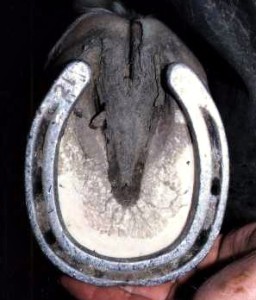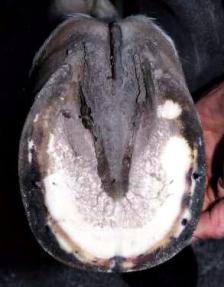Navicular Syndrome/Disease

The classic navicular syndrome shape is a long foot, wider at the toe than the quarter with narrow contracted heels and frog. The hoof wall angle at the quarters is upright and in this case the toe is long and the heels are short and so is the shoe. This is not how to shoe for a good result. This horse was very lame.
It is important to mention that farriery trends vary throughout the world vary, and that what is considered normal practice in one country or location may be considered very abnormal in another. For example, contacted feet with long, upright heels may be common in Europe where horses are stabled during winter. In Australia, most horses live in paddocks until 2 years of age, and flat feet and underrun heels are common in many areas. These predisposing factors are due to a combination of genetically inherited foot conformation, breed, overall management, diet, exercise, stabling, frequency of farriery care and the skill of the farrier. Genetic and environmental variety is reflected in the varying causes of navicular syndrome. Farriery, breed and management are significant factors influencing whether a horse does develop navicular syndrome, and just like laminitis, the risk of a horse developing navicular syndrome is reduced by improved farriery and horse management practices.
A chronic degeneration of the navicular bone in which there is damage to its flexor surface and the overlying flexor tendon in the front feet of the horse. There may be an accompanying navicular bursitis and osteophyte (bony outgrowth) formation. The syndrome is characterised by intermittent lameness (Blood and Studdert, 1999).



Leave a Reply
Want to join the discussion?Feel free to contribute!